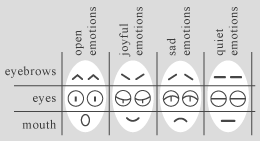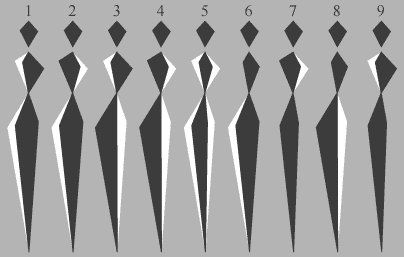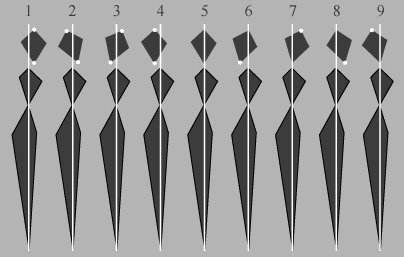Methods of identification of psychological types in a context of analytical
physiognomy mean observation of emotional conditions as displays of
psychological types are displayed in features of a human face, and movements of
facial features are displays of emotions. Namely not only active or passive
features of a face can testify to psychological type of the man, but also
emotions peculiar to the man or otherwise tell emotional expressions can testify
to psychological type indirectly.
According to system of symbolical images it is possible to allocate four kinds
of emotions which are connected to three levels of a human face that is shown on
the chart:
 |
The shown emotions are symbolical but correspond to
real emotional expressions of human faces: - open emotions correspond to open expression of eyebrows, and also open expression of eyes and open expression of a mouth; - joyful emotions correspond to enthusiastic expression of eyebrows, and also joyful expression of eyes and joyful expression of a mouth; - sad emotions correspond to sad expression of eyebrows and sad expression of eyes and sad expression of a mouth; - quiet emotions correspond to the not indignant expression of eyebrows, and also to the closed expression of eyes and the closed expression of a mouth. The detailed information on values of the shown emotional expressions look on pages of this website in the other section which has the name concepts of the canon of changes I Ching and also in section which has the name emotional types. |
Open and joyful emotions are peculiar to sensory and ethical extraverted
psychological types. Sad and quiet emotions are peculiar to logic and intuitive
introverted psychological types. Namely emotional expressions of facial features
correspond with physiognomic attributes of psychological parameters of a human
person:
- open or joyful expressions of eyebrows correspond with attributes of active or
obvious ethical function;
- quiet or sad expressions of eyebrows correspond with attributes of active or
obvious logic function;
- open or joyful expressions of eyes correspond with attributes of active or
obvious extraversion;
- quiet or sad expressions of eyes correspond with attributes of active or
obvious introversion;
- open or joyful expressions of a mouth correspond with attributes of active or
obvious sensory function;
- quiet or sad expressions of a mouth correspond with attributes of active or
obvious intuitive function.
For example, the following emotional conditions can be peculiar to 30th
psychological type of analytical physiognomy:
30








And also the shown emotional conditions are peculiar to 33rd 56th 13th 30th
12th 35th 25th 21st psychological types which have attributes of active or
obvious extraversion, and can be shown according to active or obvious logic
function, and can be shown according to active or obvious sensory function.
Other ratio of psychological types of analytical physiognomy with emotional
expressions of human faces are shown in gallery:
![]()
Also the human body allows to identify psychological types of analytical physiognomy, namely according to prevailing positions or otherwise to tell according to poses of a body it is possible to speak about mental functions of a human person, as shown in the chart:
 |
White contours show deviations of corporal levels
backward or forward. Dark contours show a body. If white contours are seen ahead then dark contours of a body are deviated backward, and if white contours are seen behind then dark contours of a body are deviated forward. The top level of a human body is named as a torso, and the bottom level of a body is named as a trunk. Look the detailed information on poses (postures) of a human body on pages of other website: www.labyrinthgallery.64g.ru Soon I shall translate this information on the English language. |
Deviations of a torso backward is peculiar if logic function is shown.
Deviations of a torso forward is peculiar if ethical function is shown.
Deviations of a trunk backward is peculiar if intuitive function is shown.
Deviations of a trunk forward is peculiar if sensory function is shown.
The first figure corresponds to the pose of a body according to which a
person is shown as ethical-sensory or sensory-ethical type because the torso and
trunk are deviated forward.
The second figure corresponds to the pose of a body according to which a
person is shown as logic-sensory or sensory-logic type because the torso is
deviated backward and the trunk is deviated forward.
The third figure corresponds to the pose of a body according to which a
person is shown as ethical-intuitive or intuitive - ethical type because the
torso is is deviated forward and the trunk is deviated backward.
The fourth figure corresponds to the pose of a body according to which a
person is shown as logic-intuitive or intuitive - logic type because the torso
and trunk are deviated backward.
The fifth figure corresponds to the pose of a body according to which a
person does not show attributes of those or other prevailing mental functions
because the body has average position without deviations forward or backward.
The sixth figure corresponds to the pose of a body according to which a
person is shown as sensory type because the trunk is deviated forward and the
torso has average position.
The seventh figure corresponds to the pose of a body according to which a
person is shown as logic type because the torso is deviated backward and the
trunk has average position.
The eighth figure corresponds to the pose of a body according to which a
person is shown as intuitive type because the trunk is deviated backward and the
torso has average position.
The ninth figure corresponds to the pose of a body according to which a
person is shown as ethical type because the torso is deviated forward and the
trunk has average position.
Besides it is possible to identify psychological types of analytical physiognomy
according to positions of a head, as shown in the following chart:
 |
The white line shows the average vertical of a body,
and deviations of a head from the average vertical are specified by
white points. Namely if a head top or a chin are deviated forward then
white points are at the right of vertical, and if a head top or a chin
are deviated backward then white points are at the left of vertical. If
a head top or a chin are not deviated then coincide with the average
vertical. Look the detailed information on positions of a head on pages of other website: www.labyrinthgallery.64g.ru Soon I shall translate this information on the English language. |
Deviations of a head top are peculiar if attributes of extraversion and logic
function are shown, or attributes of introversion and ethical function are
shown.
Deviations of top of a head back are peculiar if attributes of extraversion and
ethical function are shown, or attributes of introversion and logic function are
shown.
Deviations of a chin forward are peculiar if attributes of extraversion and
intuitive function are shown, or attributes of introversion and sensory function
are shown.
Deviations of a chin back are peculiar if attributes of extraversion and sensory
function are shown, or attributes of introversion and intuitive function are
shown.
The first figure corresponds to the position of a head according to which
a person is shown as logic-intuitive extraverted or intuitive-logic extraverted
type, or as ethical-sensory introverted or sensory-ethical introverted type
because the head top and chin are deviated forward.
The second figure corresponds to the position of a head according to
which a person is shown as ethical-intuitive extraverted or intuitive-ethical
extraverted type, or as sensory-logic introverted or logic-sensory introverted
type because the head top is deviated backward and the chin is deviated forward.
The third figure corresponds to the position of a head according to which
a person is shown as logic-sensory extraverted or sensory-logic extraverted
type, or as intuitive-ethical introverted or ethical-intuitive introverted type
because the head top is deviated forward and the chin is deviated backward.
The fourth figure corresponds to the position of a head according to
which a person is shown as ethical-sensory extraverted or sensory-ethical
extraverted type, or as logic-intuitive introverted or intuitive-logic
introverted type because the head top and chin are deviated backward.
The fifth figure corresponds to the position of a head according to which
a person does not show attributes of those or other prevailing mental functions
because the head top and chin have average position without deviations from the
vertical.
The sixth figure corresponds to the position of a head according to which
a person is shown as sensory extraverted or intuitive introverted type because
the chin is deviated backward and the head top has average position.
The seventh figure corresponds to the position of a head according to
which a person is shown as logic extraverted or ethical introverted type because
the head top is deviated forward and the chin has average position.
The eighth figure corresponds to the position of a head according to
which a person is shown as intuitive extraverted or sensory introverted type
because the chin is deviated forward and the head top has average position.
The ninth figure corresponds to the position of a head according to which
a person is shown as ethical extraverted or logic introverted type because the
head top is deviated backward and the chin has average position.
It is necessary to take into account that the listed poses of a body and
positions of a head are inherent in all psychological types as correspond with
displays of emotions which are general, but nevertheless the listed poses of a
body and positions of a head are most peculiar to the appropriate psychological
types, that is possible to consider during identification.
The following page represents methods of numerological calculations according to which it is possible to identify psychological types of analytical physiognomy.